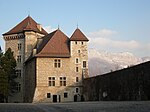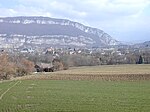Église Saint-Maurice, Annecy
Buildings and structures in AnnecyChurches in Haute-SavoieFrance Roman Catholic church stubs

Église Saint-Maurice (in English, St. Maurice Church) is a Roman Catholic church in Annecy, France. It is the oldest church in Annecy. It was originally built as a chapel of a Dominican convent in 1422, sponsored by Cardinal Jean-Allarmet de Brogny.The church has a Gothic style architecture. Chapels are built in different parts of the nave by noble families or artisan corporations from 1478 onwards, forming the present lower sides of the church. Notably, there is a 15th-century "trompe-l'œil" painting to the left of the choir.The building is designated as a national monument in 1957.
Excerpt from the Wikipedia article Église Saint-Maurice, Annecy (License: CC BY-SA 3.0, Authors, Images).Église Saint-Maurice, Annecy
Rue Saint-Maurice, Annecy
Geographical coordinates (GPS) Address External links Nearby Places Show on map
Geographical coordinates (GPS)
| Latitude | Longitude |
|---|---|
| N 45.899166666667 ° | E 6.1277777777778 ° |
Address
Église Saint-Maurice
Rue Saint-Maurice
74000 Annecy (Annecy)
Auvergne-Rhône-Alpes, France
Open on Google Maps







